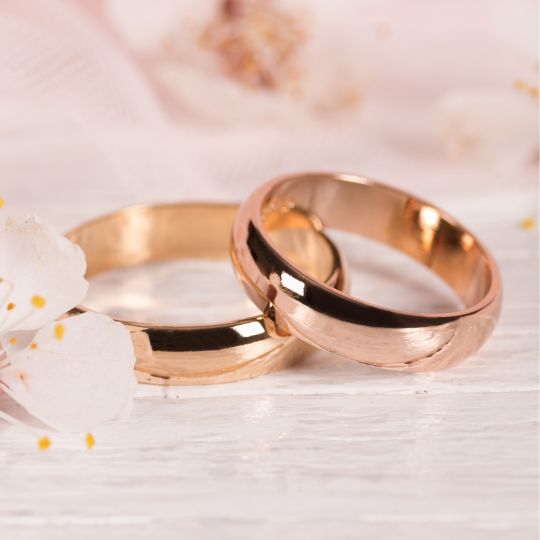Wedding Rings: Essential
symbols or outdated tradition?
/08
by Jennifer
Cram - Brisbane Marriage Celebrant © 03/02/2024Categories: | Wedding Ceremony | Wedding Rings | Wedding Rituals |
 Tradition expects a wedding ceremony
to include an exchange of rings, or at least, a
ring being put on the bride's finger. Exchanging
rings during the ceremony is, for most couples, a
must. However, being ringless on the
day will not create a problem with the legality of
your marriage. Despite lingering folklore, "With
this ring I thee wed" is not a legally
required statement. And exchanging rings is not a
legal requirement. In fact, the Marriage Act
doesn't mention wedding rings at all.
Tradition expects a wedding ceremony
to include an exchange of rings, or at least, a
ring being put on the bride's finger. Exchanging
rings during the ceremony is, for most couples, a
must. However, being ringless on the
day will not create a problem with the legality of
your marriage. Despite lingering folklore, "With
this ring I thee wed" is not a legally
required statement. And exchanging rings is not a
legal requirement. In fact, the Marriage Act
doesn't mention wedding rings at all. So why do we still regard the exchange of ring to be a central moment in both civil and religious (Christian) wedding ceremonies? And why is it generally expected that, by the time a heterosexual couple is declared married, the bride will have a ring on her finger, but the groom may or may not?
History has a lot to do with it. And so has the human habit of attributing new ideas to an origin long ago and far away in order to convey an impression of rock-solid provenance!
The Egyptians had nothing
to do with it
Nonetheless, I've lost count of the number of times I've read that wearing a ring as a visible sign of the wearer's married status is a tradition that dates back to ancient Egypt, an uncritically repeated but unsubstantiated 'factoid' that's often embellished by the suggestion that wedding rings at that time were made of plaited grass, leather, or other materials unlikely to survive.
There is also no evidence to suggest that ancient Egyptians believed that a vein (supposedly subsequently named vena amoris - literally vein of love - by the Romans) ran from the left ring finger directly to the heart. Does such a vein even exist? No, The blood vessels in both hands are pretty much all the same, and there isn't one vein in them that is linked directly to the heart. In fact, the whole story probably originated in medieval times, demonstrates the fairly common desire to credit an ancient origin fo custom, despite the fact that in many countries the wedding ring is worn on the right hand.
Rings
in Ancient Greece and Rome
In Ancient Greece and Rome, the giving of a
ring to the bride seems to have been a pledge as the
earnest of the future fulfilment of the groom's side
of the marriage contract. It wasn't part of any
ceremony of marriage. Rings
in Ancient Greece and Rome
The Catholic
Church
The ceremony, however, was not originally a marriage ceremony as we understand it today. When we look at liturgical books used throughout Europe in the early middle Ages, the ceremonies that involved exchanges of wedding rings were betrothals, regarded to be legally binding although they marked the period of engagement.
It was the Council of Trent (1545-1563), called to affirm basic Catholic doctrines against statements made by members of the Protestant faith, that made the giving of a wedding ring during the marriage ceremony, compulsory.
The Council codified the rite of marriage. In doing so it made clear the Church's view that the betrothal was a private, family agreement, while marriage was a sacrament. What had been the betrothal ceremony was incorporated in the rite of marriage in the form of the consent questions asked of the couple before they take their vows. The "I do/I will" questions.
The Council also decreed a specific ritual for the placing of a ring on the bride's finger, thereby making the giving of a ring, compulsory. What had earlier been a symbol of earnest, became a symbol of the marriage, and specifically a symbol of the role and commitment of the bride as a wife. In modern terms, the bride was tagged as a married woman!
The Church of
England
The 1559 service required the groom to say 'With this rynge I thee wed' as he placed the ring on the bride's finger, followed by 'this gold and silver I thee give’ as he handed her a purse filled with gold and silver coins, before he continuing, ’with my body I thee worship, and with all my worldly chatels I thee endow.’
The
Puritans cancelled
wedding rings
When James I was on the way to his coronation,
he was petitioned by Puritans to remove the giving
of a marriage ring from the marriage service on the
grounds that it was "popish" and not mentioned in
the Bible. Their petition failed in England, but in
Colonial America marriage ceremonies were pared down
to the consent question. Instead of a wedding ring,
it became the custom for a man to present his
intended with a thimble, being an object of
practical use.The
Puritans cancelled
wedding rings
The Groom
finally gets a ring
The double-ring ceremony, where both
the bride and groom receive a ring, is a recent
innovation. The jewellery industry started marketing
wedding rings for men in the 19th century,but it
didn't really start to catch on until World War II.
And it did not become virtually universally accepted
until quite late in the 20th century, largely due to
the global marketing efforts of the manufacturers of
rings.The Groom
finally gets a ring
Wedding
rings in the modern
civil ceremony
The exchange of rings, with or
without ring vows, remains a much-loved and central
part of both religious and civil ceremonies. It is
so engrained that, perpetuating the idea that you
can't get married without rings, celebrants often
carry a set of cheap rings to substitute when and if
the couple forgets to
bring their rings. Wedding
rings in the modern
civil ceremony
In religious ceremonies the rings are blessed. In civil ceremonies the rings may be passed around the guests in a secular blessing ritual, warming of the rings. The celebrant will often share some thoughts about the symbolism of the rings, mentioning endless circles, precious metals, fidelity, love, and a symbolic representation of the vows made by the couple.
It's your
choice
Go with the tradition
or forge your own tradition. It's your choice in a
civil ceremony.Rings or no rings. Ring vows or a
silent exchange or exchange of rings during your
legal vows. Substitute something else that's
meaningful to you both. Be pragmatic, as several of
my couples have been, and forgo exchanging rings in
the ceremony because you plan purchase your rings
duty free as you leave for your overseas honeymoon,
or buy them overseas where they are cheaper.It's your
choice
Whatever you decide, it's fine!
Thanks for reading!

pullin0 Things